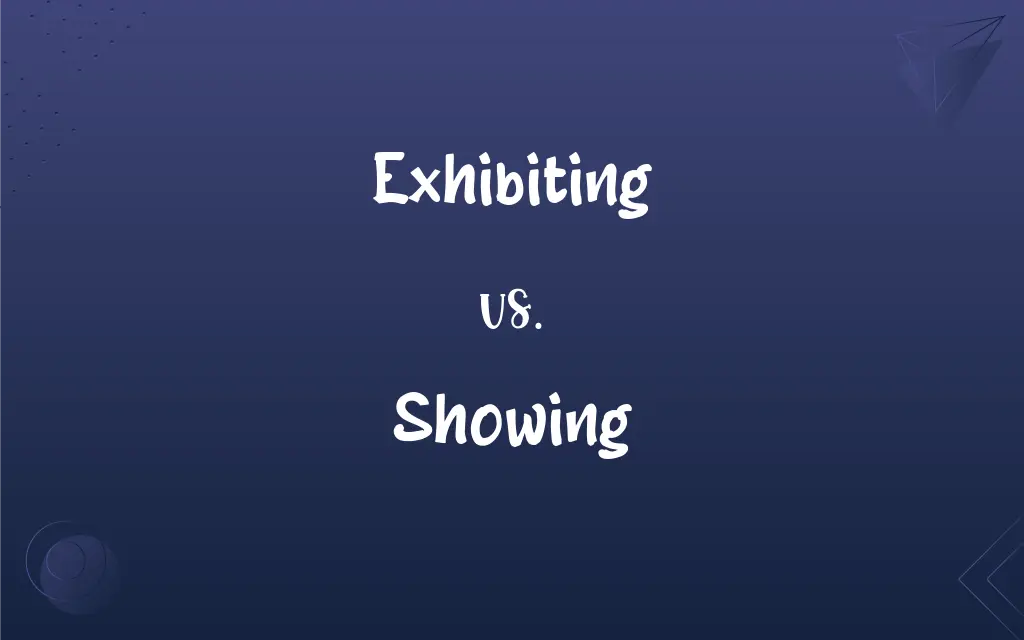Exhibiting vs. Showing: What's the Difference?
Edited by Harlon Moss || By Janet White || Published on January 19, 2024
Exhibiting involves presenting something systematically for public view, often in a formal or educational context, while showing is a broader term for simply presenting or displaying something.

Key Differences
Exhibiting often implies a formal or public display, especially in an artistic or educational setting, like a museum or gallery. Showing is more general and can refer to any act of making something visible or known.
Exhibiting usually has an element of purposeful arrangement and curation, aiming to inform, educate, or evoke certain responses. Showing can be more casual or spontaneous, lacking the structured intent of an exhibit.
Exhibiting often suggests a larger scale or a more comprehensive display of items or information. In contrast, showing can refer to the display of a single item or a simple act of presentation.
Exhibiting typically involves engaging the audience in a deeper, more interactive manner, often encouraging reflection or learning. Showing might not seek to engage the audience beyond the basic act of viewing.
Exhibiting carries connotations of professionalism, organization, and education. Showing is more neutral and can be used in a wider range of informal or personal contexts.
ADVERTISEMENT
Comparison Chart
Context
Formal, educational settings
Any setting
Purpose
To inform, educate, or curate
To present or reveal
Scope
Often comprehensive
Can be singular or simple
Audience Interaction
Interactive and reflective
Often just viewing
Connotations
Professional, organized
Neutral, broader usage
ADVERTISEMENT
Exhibiting and Showing Definitions
Exhibiting
Showcasing with educational or informative intent.
The science fair exhibited innovative student projects.
Showing
Presenting for view or consideration.
He's showing his project to the committee.
Exhibiting
Displaying in a structured manner.
The museum is exhibiting ancient artifacts next month.
Showing
Displaying or making visible.
She is showing her paintings at the local café.
Exhibiting
Presenting systematically for public viewing.
The artist is exhibiting her new collection at the gallery.
Showing
Revealing or demonstrating.
The teacher is showing how to solve the equation.
Exhibiting
Demonstrating or revealing in a formal setting.
The conference exhibited the latest technological advancements.
Showing
Exhibiting in a more casual sense.
They are showing family photos at the reunion.
Exhibiting
Arranging publicly in an organized fashion.
The photographs were exhibited in chronological order.
Showing
Broadcasting or screening.
The cinema is showing the latest blockbuster movie.
Exhibiting
To show outwardly; display
Exhibited pleasure by smiling.
Showing
The act of presenting or displaying.
Exhibiting
To present for others to see
Rolled up his sleeve to exhibit the scar.
Showing
Performance, as in a competition or test of skill
A poor showing.
Showing
A presentation of evidence, facts, or figures.
Showing
Present participle of show
Showing
An occasion when something is shown.
We went to the midnight showing of the new horror movie.
Showing
A result, a judgement.
He made a poor showing at his first time at bat.
Showing
Appearance; display; exhibition.
Showing
Presentation of facts; statement.
Showing
The display of a motion picture
Showing
Something shown to the public;
The museum had many exhibits of oriental art
FAQs
What does showing mean?
Showing means making something visible or presenting it, without necessarily implying a formal context.
Do museums exhibit or show items?
Museums typically exhibit items, curating them for public education and engagement.
Can exhibiting be informal?
While typically formal, exhibiting can be informal depending on the context and manner of display.
How do artists use exhibiting?
Artists use exhibiting to systematically display their works, often in galleries or art shows.
What are key elements of exhibiting?
Key elements include organization, purposeful arrangement, and often an educational or informative intent.
Is showing a part of exhibiting?
Yes, showing is a component of exhibiting but is broader and less structured.
Is showing always public?
No, showing can be public or private, depending on the situation.
Can an individual show something informally?
Yes, showing can be as simple as presenting something to a friend.
What venues are suitable for exhibiting?
Galleries, museums, and educational institutions are typical venues for exhibiting.
What is exhibiting?
Exhibiting refers to displaying items or information in a structured, often public and formal manner.
Can showing be used in digital contexts?
Yes, showing is widely used in digital contexts, like showing a presentation or video online.
What skills are needed for exhibiting?
Skills include curation, organization, and often knowledge of the subject matter.
Is a casual display considered exhibiting?
A casual display is more often referred to as showing, unless it involves structured arrangement.
Can showing be unintentional?
Yes, one can show something unintentionally, unlike exhibiting which is usually deliberate.
How do artists benefit from exhibiting?
Artists benefit by gaining exposure, engaging with audiences, and often selling their work.
Does exhibiting require special preparation?
Generally, yes, exhibiting often requires more preparation than showing.
What impact does exhibiting have on an audience?
Exhibiting aims to engage, educate, or evoke specific responses from an audience.
Can showing be interactive?
Yes, showing can be interactive, especially in informal or educational settings.
Can anyone exhibit their work?
While anyone can exhibit, access to formal venues might require certain criteria or selection processes.
Is showing always visual?
Primarily, but showing can also involve other senses, like showing music or a fragrance.
About Author
Written by
Janet WhiteJanet White has been an esteemed writer and blogger for Difference Wiki. Holding a Master's degree in Science and Medical Journalism from the prestigious Boston University, she has consistently demonstrated her expertise and passion for her field. When she's not immersed in her work, Janet relishes her time exercising, delving into a good book, and cherishing moments with friends and family.
Edited by
Harlon MossHarlon is a seasoned quality moderator and accomplished content writer for Difference Wiki. An alumnus of the prestigious University of California, he earned his degree in Computer Science. Leveraging his academic background, Harlon brings a meticulous and informed perspective to his work, ensuring content accuracy and excellence.






































































